Whitepapers
MySQL load balancing with HAProxy
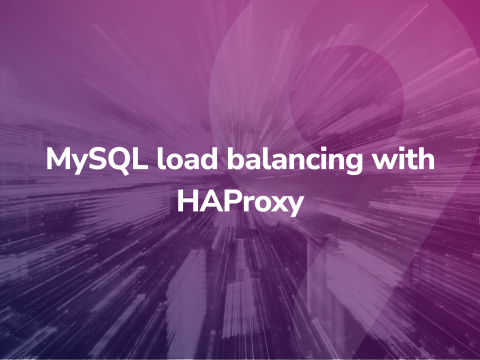
Applications typically connect to a database cluster or replicated setup by opening connections on one of the database nodes in order to run transactions. If the database node fails, the client would need to reconnect to another database node before it can continue to serve requests.
There are different ways to provide connectivity to one or more MySQL database servers. One way is to use a database driver that supports connection pooling, load balancing and failover for example:
The above database drivers are built to provide transparency for clients when connecting to standalone MySQL server, MySQL Cluster (NDB) or MySQL replication setups. However, in other clustering setup like Galera Cluster for MySQL or MariaDB, the JDBC and PHP drivers are not aware of internal Galera state information. For instance, a Galera donor node might be in read-only while it is helping another node resynchronize (if SST method is mysqldump or rsync) or it could be up in Non-Primary state if split-brain happens. Another solution is to use a load balancer between the clients and the database cluster.
This tutorial will walk you through on how to deploy, configure and manage MySQL load balancing with HAProxy using ClusterControl.
Content of the white paper
- What is HAProxy?
- Health checks for MySQL
- Failure detection and failover
- Read / write splitting with HAProxy
- Integration with ClusterControl
- HAProxy redundancy with Keepalived
- HAProxy statistics
- Troubleshooting and workarounds
What is HAProxy?
HAProxy stands for High Availability Proxy, and is a great software-based TCP/HTTP load balancer. It distributes a workload across a set of servers to maximize performance and optimize resource usage. HAProxy built with sophisticated and customizable health checks methods, allowing a number of services to be load balanced in a single running instance.
A front-end application that relies on a database backend can easily over-saturate the database with too many concurrent running connections. HAProxy provides queuing and throttling of connections towards one or more MySQL Servers and prevents a single server from becoming overloaded with too many requests. All clients connect to the HAProxy instance, and the reverse proxy forwards the connection to one of the available MySQL Servers based on the load-balancing algorithm used.
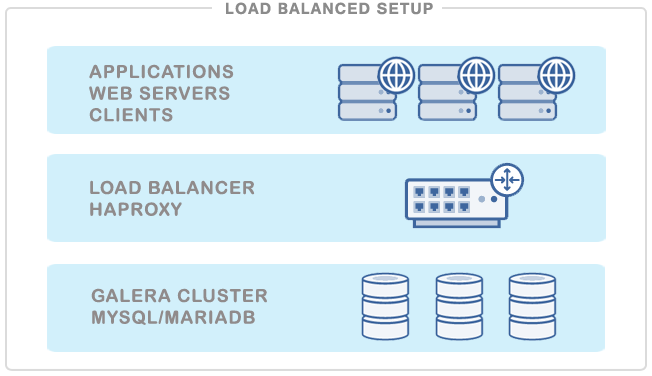
One possible setup is to install an HAProxy on each web server (or application server making requests on the database). This works fine if there are only a few web servers, so as the load introduced by the health checks is kept in check. The web server would connect to the local HAProxy (e.g. making a mysql connection on 127.0.0.1:3306), and can access all the database servers. The Web and HAProxy together forms a working unit, so the web server will not work if the HAProxy is not available.
With HAProxy in the load balancer tier, you will have following advantages:
- All applications access the cluster via one single IP address or hostname. The topology of the database cluster is masked behind HAProxy.
- MySQL connections are load-balanced between available DB nodes.
- It is possible to add or remove database nodes without any changes to the applications.
- Once the maximum number of database connections (in MySQL) is reached, HAProxy queues additional new connections. This is a neat way of throttling database connection requests and achieves overload protection.
ClusterControl support HAProxy deployment right from the UI and by default it supports three load-balancing algorithms – roundrobin, leastconn or source. We recommend users to have HAProxy in between clients and a pool of database servers, especially for Galera Cluster or MySQL Cluster where the backends are being treated equally.
Health Checks for MySQL
It is possible to have HAProxy check that a server is up by just making a connection to the MySQL port (usually 3306) however this is not good enough. The instance might be up, but the underlying storage engine might not be working as it should be. There are specific checks need to be passed, depending on whether the clustering type is Galera, MySQL Replication or MySQL Cluster.
Health Check Script
The best way to perform MySQL health check is by using a custom shell script which determines whether a MySQL server is available by carefully examining its internal state which depends on the clustering solution used. By default, ClusterControl provides its own version of health check script called mysqlchk, resides on each MySQL server in the load balancing set and has ability to return an HTTP response status and/or standard output (stdout) which is useful for TCP health check.
mysqlchk for Galera Cluster
If the backend MySQL server is healthy, then the script will return a simple HTTP 200 OK status code with exit status 0. Else, the script will return 503 Service unavailable and exit status 1. Using xinetd is the simplest way to get the health check script executed by making it daemonize and listen to a custom port (default is 9200). HAProxy will then connect to this port and request for a health check output. If the health check method is httpchk, HAProxy will look for the HTTP response code and if the method is tcp-check, it will look for the expect string (as shown in section 3.2.3).
The following flowchart illustrates the process to report the health of a Galera node for multi-master setup:
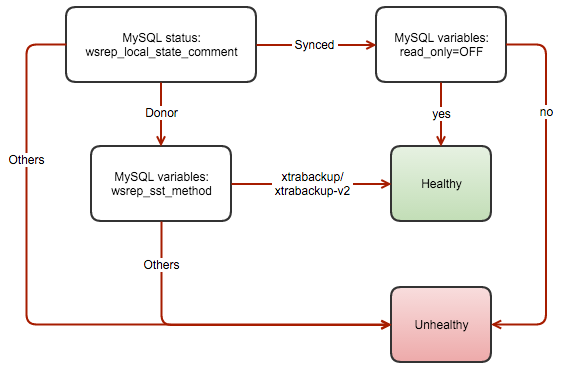
The template file is located at /usr/share/cmon/templates/mysqlchk.galera on ClusterControl server. This mysqlchk script is automatically installed by ClusterControl on each Galera node participating in the load balancing set.
mysqlchk for MySQL Replication
This script is based on the standard mysqlchk script but tailored to monitor MySQL Replication backend servers correctly. The template is available at this Github repository, and you can use it by replacing the default template located /usr/share/cmon/templates/mysqlchk.mysql before the HAProxy deployment begins. It’s similar with mysqlchk for Galera Cluster where xinetd is required to daemonize the health check script.
The script detects the MySQL Replication role based on the following flow chart:
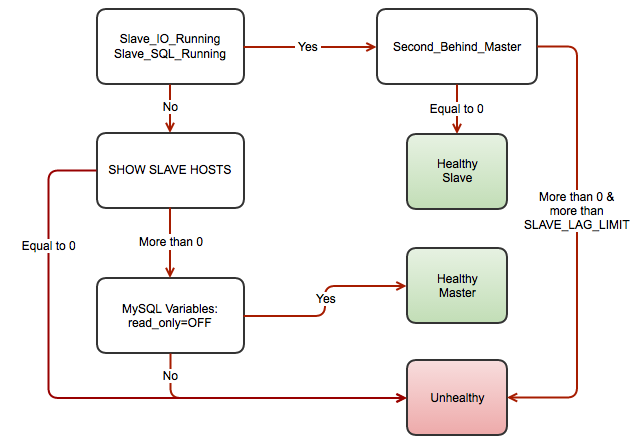
Setting up HAProxy for MySQL Replication requires two different HAProxy listeners e.g, port 3307 for writes to the master and port 3308 for reads to all available slaves (including master). We have covered this in this blog post.
mysqlchk-iptables for Galera Cluster
A background script that checks the availability of a Galera node, and adds a redirection port using iptables if the Galera node is healthy (instead of returning HTTP response). This allows other TCP-load balancers with limited health check capabilities to monitor the backend Galera nodes correctly.
Other than HAProxy, you can now use your favorite reverse proxy to load balance requests across Galera nodes, namely:
- nginx 1.9 (–with-stream)
- keepalived
- IPVS
- distributor
- balance
- pen
This health check script is out of the scope of this tutorial since it built for TCP-load balancers (other than HAProxy) with limited health check capabilities to monitor the backend Galera nodes correctly. You can watch it in action in the following screencast:
This is covered in details in this blog post, nginx as Database Load Balancer for MySQL Galera Cluster.
Health Check Methods
HAProxy determines if a server is available for request routing by performing so called health checks. HAProxy supports several backend health check methods usable to MySQL through the following options:
- mysql-check
- tcp-check
- httpchk
mysql-check
The check consists of sending two MySQL packets, one Client Authentication packet, and one QUIT packet, to correctly close the MySQL session. HAProxy then parses the MySQL Handshake Initialisation packet and/or Error packet. It is a basic but useful test which does not produce error or aborted connect on the server. However, it requires adding an authorization in the MySQL table, like this:
USE mysql;
INSERT INTO user (Host,User) values ('<ip_of_haproxy>','<username>');
FLUSH PRIVILEGES;Take note that this does not check database presence nor database consistency. To do this, we must use an external check (via xinetd) which is explained in the next section.
tcp-check
By default, if “check” is set, the server is considered available when it’s able to accept periodic TCP connections. This is not robust enough for a database backend, since the database server might be able to respond to connection requests while being in a non-operational state. The instance might be up, but the underlying storage engine might not be working properly. Also, there are specific checks that need to be done, depending on whether the clustering type is Galera or MySQL Cluster (NDB).
mysqlchk script provided by ClusterControl supports returning HTTP status code and standard output (stdout). By utilizing the stdout in xinetd, we can extend the tcp-check capability to make it more accurate with the Galera or MySQL Replication node status. The following example configuration shows the usability of it:
listen haproxy_192.168.55.110_3307
bind *:3307
mode tcp
timeout client 10800s
timeout server 10800s
balance leastconn
option tcp-check
tcp-check expect string is\ running.
option allbackups
default-server port 9200 inter 2s downinter 5s rise 3 fall 2 slowstart 60s maxconn 64 maxqueue 128 weight 100
server galera1 192.168.55.111:3306 check
server galera2 192.168.55.112:3306 check
server galera3 192.168.55.113:3306 checkThe above configuration lines tell HAProxy to perform health checks using TCP send/expect sequence. It connects to port 9200 of the database and expect for string that contains “is\ running” (backslash is used to escape whitespace). To verify the mysqlchk output through xinetd port 9200, perform telnet to the database node on HAProxy node:
$ telnet 192.168.55.111 9200
Trying 192.168.55.171...
Connected to 192.168.55.171.
Escape character is '^]'.
HTTP/1.1 200 OK
Content-Type: text/html
Content-Length: 43
<html><body>MySQL is running.</body></html>
Connection closed by foreign host.You can use the similar configuration for MySQL Replication, where the expect string for master is “MySQL Master is running”. For more details on an example deployment of HAProxy as MySQL Replication load balancer, please read this blog.
ClusterControl defaults to use httpchk as described in the next section.
httpchk
Option httpchk uses HTTP protocol to check on the servers health. This is common if you want to load balance an HTTP service, where HAProxy ensures the backend returns specific HTTP response codes before routing the incoming connections. This option does not necessarily require an HTTP backend, it also works with plain TCP backends. Using httpchk is the preferred option whenever possible since it utilizes less resources with stateless HTTP connection.
listen haproxy_192.168.55.110_3307
bind *:3307
mode tcp
timeout client 10800s
timeout server 10800s
balance leastconn
option httpchk
option allbackups
default-server port 9200 inter 2s downinter 5s rise 3 fall 2 slowstart 60s maxconn 64 maxqueue 128 weight 100
server galera1 192.168.55.111:3306 check
server galera2 192.168.55.112:3306 check
server galera3 192.168.55.113:3306 checkThe example above tells us that HAProxy will connect to port 9200, where xinetd is listening on the database servers. HAProxy will look for an expected HTTP response code. The mysqlchk script will return either ‘HTTP 200 OK’ if the server is healthy or otherwise ‘HTTP 503 Service not available’.
Failure Detection and Failover
When a database node fails, the database connections that have been opened on that node will also fail. It is important that HAProxy does not redirect new connection requests to the failed node.
There are several user defined parameters that determine how fast HAProxy will be able to detect that a server is not available. The following is the example HAProxy configuration deployed by ClusterControl located at /etc/haproxy/haproxy.cfg:
listen haproxy_192.168.55.110_3307
bind *:3307
mode tcp
timeout client 10800s
timeout server 10800s
balance leastconn
option httpchk
option allbackups
default-server port 9200 inter 2s downinter 5s rise 3 fall 2 slowstart 60s maxconn 64 maxqueue 128 weight 100
server galera1 192.168.55.111:3306 check
server galera2 192.168.55.112:3306 check
server galera3 192.168.55.113:3306 checkQuick explanation for each line above:
- listen: Listen section defines a complete proxy with its frontend and backend parts combined in one section. It is generally useful for TCP-only traffic. Specify the HAproxy instance name next to it. The next line describing the section must be indented.
- bind: Bind to all IP addresses on this host on port 3307. Your clients will have to connect to the port defined in this line.
- mode: Protocol of the instance. For MySQL, the instance should work in pure TCP mode. A full-duplex connection will be established between clients and servers, and no layer 7 examination will be performed.
- timeout client: Maximum inactivity time in the client side. It’s recommended to keep the same value with timeout server for predictability.
- timeout server: Maximum inactivity time in the server side. It’s recommended to keep the same value with timeout client for predictability.
- balance: Load balancing algorithm. ClusterControl is able to deploy leastconn, roundrobin and source, though you can customize the configuration at a later stage. Using leastconn is the preferred option so that the database server with the lowest number of connections receives the connection. If the database servers have the same number of connections, then roundrobin is performed to ensure that all servers are used.
- option httpchk: Perform HTTP-based health check instead. ClusterControl configures an xinetd script on each backend server in the load balancing set which returns HTTP response code.
- option allbackups: The load balancing will be performed among all backup servers when all normal ones are unavailable. This option is suitable if the MySQL server is configured as backup, as explained in the Troubleshooting & Workaround section of this tutorial.
- default-server: Default options for the backend servers listed under server option.
- port: The backend health check port. ClusterControl configures an xinetd process listening on port 9200 on each of the database node running a custom health check script.
- inter: The interval between health checks for a server that is “up”, transitionally “up or down” or not yet checked is 2 seconds.
- downinter: The down interval is 5 seconds when the server is 100% down or unreachable.
- rise: The server will be considered available after 3 consecutive successful health checks.
- fall: The server will be considered down/unavailable after 2 consecutive unsuccessful health checks.
- slowstart: In 60 seconds, the number of connections accepted by the server will grow from 1 to 100% of the usual dynamic limit after it gets back online.
- maxconn: HAProxy will stop accepting connections when the number of connection is 64.
- maxqueue: The maximal number of connections which will wait in the queue for this server. If this limit is reached, next requests will be redispatched to other servers instead of indefinitely waiting to be served.
- weight: In Galera, all nodes usually treated equally. So setting it to 100 is a good start.
- server: Define the backend server name, IP address, port and server’s options. We enabled health check by using the check option on each of the server. The rest option are the same as under default-server.
From the above configurations, the backend MySQL server fails at health checks when:
- HAProxy was unable to connect to port 9200 of the MySQL server
- If 9200 is connected, the HTTP response code sent by MySQL server returns other than HTTP/1.1 200 OK (option httpchk)
Whereby, the downtime and uptime chronology would be:
- Every 2 seconds, HAProxy performs health check on port 9200 of the backend server (port 9200 inter 2s).
- If the health check fails, the fall count starts and it will check for the next failure. After 5 seconds, if the second try still fails, HAProxy will mark the MySQL server as down (downinter 5s fall 2).
- The MySQL server is automatically excluded from the list of available servers.
- Once the MySQL server gets back online, if the health check succeeds, the rise count starts and it will check if the next consecutive attempt is succeeded. If the count reaches 3, the server will be marked as available (rise 3).
- The MySQL server is automatically included into the list of available servers.
- The MySQL server starts to accept the connections gradually for 60 seconds (slowstart 60s).
- The MySQL server is up and fully operational.
Read/Write Splitting with HAProxy
HAProxy as MySQL load balancer works similarly to a TCP forwarder, which operates in the transport layer of TCP/IP model. It does not understand the MySQL queries (which operates in the higher layer) that it distributes to the backend MySQL servers. Due to this, HAProxy is popular among multi-master replication setups like Galera Cluster and MySQL Cluster, where all backend MySQL servers are treated equally. All MySQL servers are able to handle the forwarded reads/writes. Operating in transport layer also consumes less overhead compared to database-aware load balancer/reverse proxy like MaxScale or ProxySQL.
In spite of that, it does not mean that HAProxy is not applicable for other non-multi-master setups especially master-slave replication. In MySQL Replication, things get a little bit complicated. Writes must be forwarded only to a master, while reads can be the forwarded to all slaves (or master) as long as the slave does not lag behind. Updating more than one master in a replication setup can result in data inconsistency and cause replication to break.
To make HAProxy capable of handling reads and writes separately, one must:
- Configure health checks for MySQL Replication. The health check script must be able to:
- Report the replication role (master, slave or none)
- Report the slave lag (if slave)
- Must be accessible by HAProxy (configured via xinetd or forwarding port)
- Create two HAProxy listeners, one for read and one for write:
- Read listener – forward to all slaves (or master) to handle reads.
- Write listener – forward writes to a single master.
- Instruct your application to send reads/writes to the respective listener:
- Build/Modify your application to have ability to send reads and writes to the respective listeners
- Use application connector which supports built-in read/write splitting. If you are using Java, you can use Connecter/J. For PHP, you can use php-mysqlnd for master-slave. This will minimize the changes on the application side.
We have covered the PHP case in details in this blog post, High availability read-write splitting with php-mysqlnd, MySQL Replication and HAProxy.
Integration with ClusterControl
ClusterControl integrates with HAProxy to ease up deployment and management of the load balancer in combination with a clustered MySQL backend like Galera or MySQL NDB Cluster. It is also possible to add an existing/already deployed HAProxy instance into ClusterControl, so you can monitor and manage it directly from ClusterControl UI together with the database nodes.
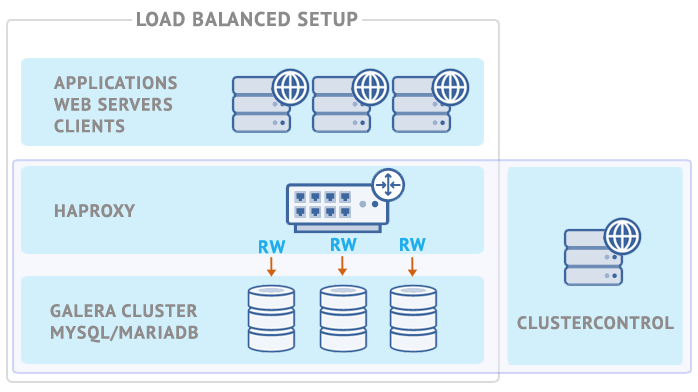
To install, you just need to go to ClusterControl > Manage > Load Balancer > Install HAProxy tab and enter the required information:
- HAProxy Address: IP address or hostname of HAProxy node. ClusterControl must be able to connect via passwordless SSH.
- Listen Port: Port that HAProxy instance will listen to. This port will be used to connect to the load-balanced MySQL connections.
- Policy: Load balancing algorithm. Supported values are:
- leastconn – The server with the lowest number of connections receives the connection.
- roundrobin – Each server is used in turns, according to their weights.
- source – The client IP address is hashed and divided by the total weight, so it will always reach the same server as long as no server goes down or up.
- Install from Package Manager: If Redhat based, install via yum package manager. For Debian-based, apt-get command will be used.
- Build from Source (latest available source package will be used:
- ClusterControl will compile the latest available source package downloaded from http://www.haproxy.org/#down.
- This option is only required if you intend to use the latest version of HAProxy or if you are having problem with the package manager of your OS distribution. Some older OS versions do not have HAProxy in their package repositories.
- Overwrite Existing /usr/local/sbin/mysqlchk on targets: If the mysqlchk script is already there, overwrite it for this deployment. If you have adjusted the script to suit your needs, you might need to uncheck this.
- Show Advanced Settings:
- Stats Socket: UNIX socket file location for various statistics outputs. Default is /var/run/haproxy.socket and it’s recommended not to change this.
- Admin Port: Port for HAProxy admin-level statistic page. Default is 9600.
- Admin User: Admin user when connecting to the statistic page.
- Admin Password: Password for Admin User
- Backend Name: The listener name for backend. No whitespace.
- Timeout Server (seconds): Maximum inactivity time in the server side.
- Timeout Client (seconds): Maximum inactivity time in the client side.
- Max Connections Frontend: Maximum per-process number of concurrent connections for the frontend.
- Max Connection Backend per instance: Limit the number of connection that can be made from HAProxy to each MySQL Server. Connections exceeding this value will be queued by HAProxy. A best practice is to set it to less than the MySQL’s max_connections to prevent connections flooding.
- xinetd allow connections from: Only allow this network to connect to the health check script on MySQL server via xinetd service.
- Server Instances: List of MySQL servers in the cluster.
- Include: Include the server in the load balancing set.
- Role: Choose whether the node is Active or Backup. In Backup mode, the server will is only used in load balancing when all other Active servers are unavailable.
Once the dialog is filled up, click on ‘Install HAProxy’ button to trigger the deployment job:
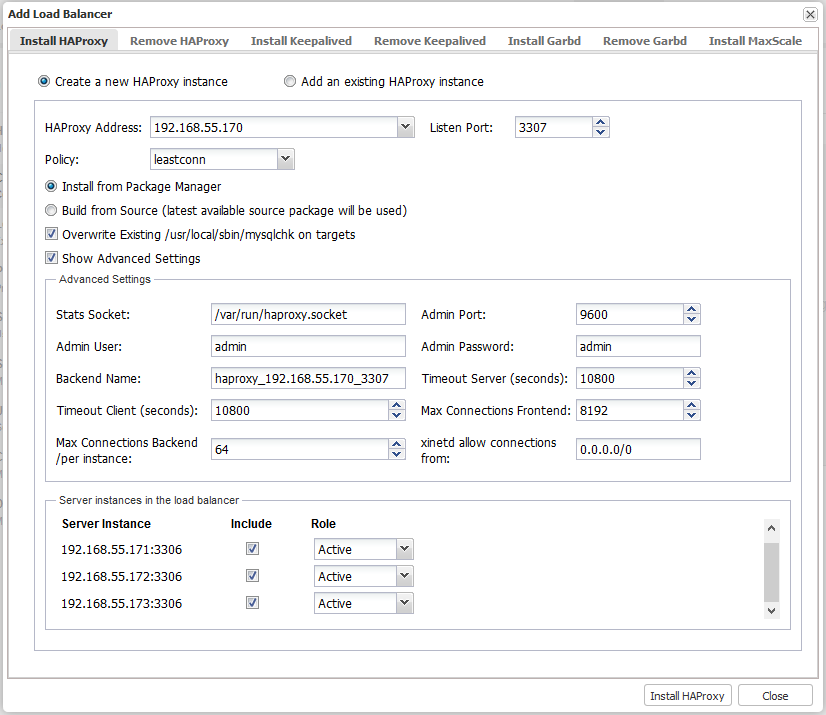
ClusterControl will perform the following tasks when the deployment job is triggered:
- Installs helper packages
- Tunes the TCP stack of the instance
- Copies and configures mysqlchk script (from template) on every Galera node
- Installs and configures xinetd at /etc/xinetd.d/mysqlchk
- Registers HAProxy node into ClusterControl
You can monitor the deployment progress under ClusterControl > Logs > Jobs, similar to example below:
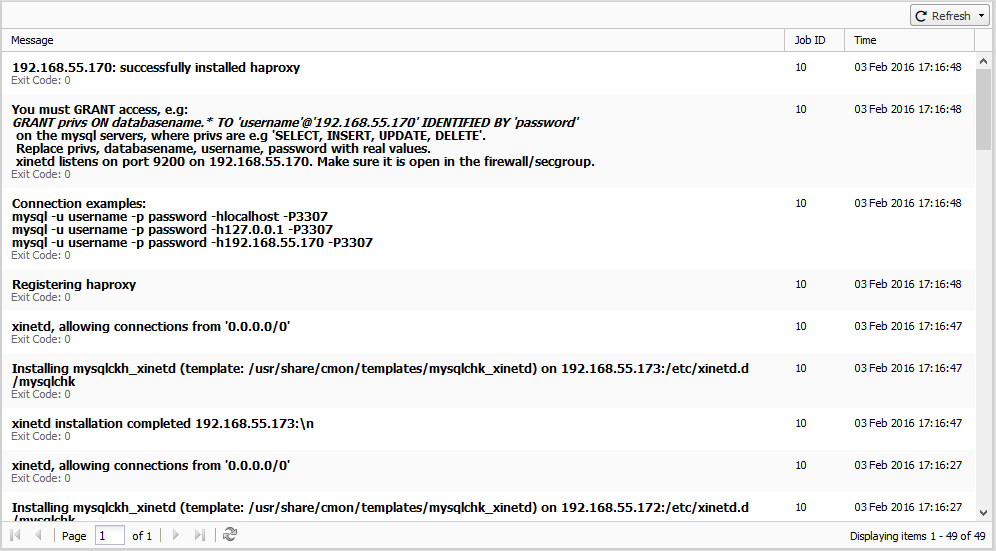
By default, the HAProxy server will listen on port 3307 for connections. In this example, the HAProxy host IP address is 192.168.55.170. You can connect your applications to 192.168.55.170:3307 and requests will be load balanced on the backend MySQL Servers.
Do not forget to GRANT access from the HAProxy server to the MySQL Servers, because the MySQL Servers will see the HAProxy making the connections, not the Application server(s) itself. In the example above, issue on the MySQL Servers the access rights you wish:
mysql> GRANT ALL PRIVILEGES ON mydb.* TO 'appuser'@'192.168.55.170' IDENTIFIED BY 'password';The HAProxy process will be managed by ClusterControl, and is automatically restarted if it fails.
HAProxy Redundancy with Keepalived
Since all applications will be depending on HAProxy to connect to an available database node, to avoid a single point of failure with your HAProxy, one would set up two identical HAProxy instances (one active and one standby) and use Keepalived to run VRRP between them. VRRP provides a virtual IP address to the active HAProxy, and transfers the Virtual IP to the standby HAProxy in case of failure. This is seamless because the two HAProxy instances need no shared state.
By adding Keepalived into the picture, our infrastructure will now look something like this:
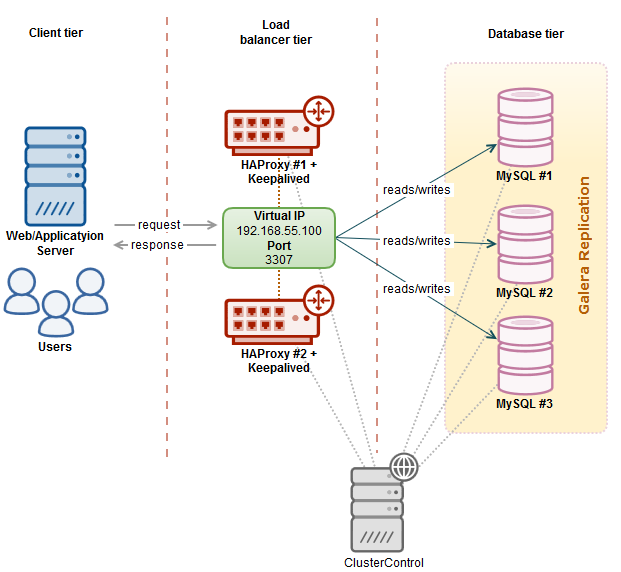
In this example, we are using two nodes to act as the load balancer with IP address failover in front of our database cluster. virtual IP (VIP) address will be floating around between HAProxy #1 (master) and HAProxy #2 (backup). When HAProxy #1 goes down, the VIP will be taking over by HAProxy #2 and once the HAProxy #1 up again, the VIP will be failback to HAProxy #1 since it hold the higher priority number. The failover and failback process is automatic, controlled by Keepalived.
You need to have at least two HAProxy instances in order to install Keepalived. Use “Install HAProxy” to install another HAProxy instance and then go to ClusterControl > Manage > Load Balancer > Install Keepalived to install or add existing Keepalived instance, as shown in the following screenshot:
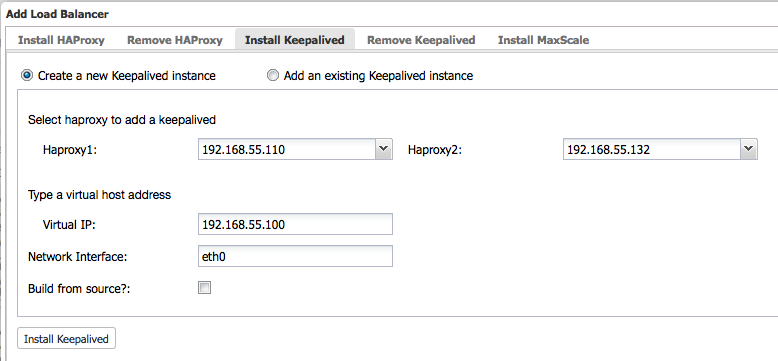
Take note that your network environment supports VRRP (IP protocol 112) for health check communication between two nodes. It’s also possible to let Keepalived run in non-multicast environment by configuring unicast, which will be used by default by ClusterControl if Keepalived installed is version 1.2.8 and later.
For more details on how ClusterControl configures Keepalived and what to expect from the failover and failback, see this blog post.
HAProxy Statistics
Other than deployment and management, ClusterControl also provides insight into HAProxy statistics from the UI. From ClusterControl, you can access the statistics page at ClusterControl > Nodes > choose the HAProxy node similar to screenshot below:
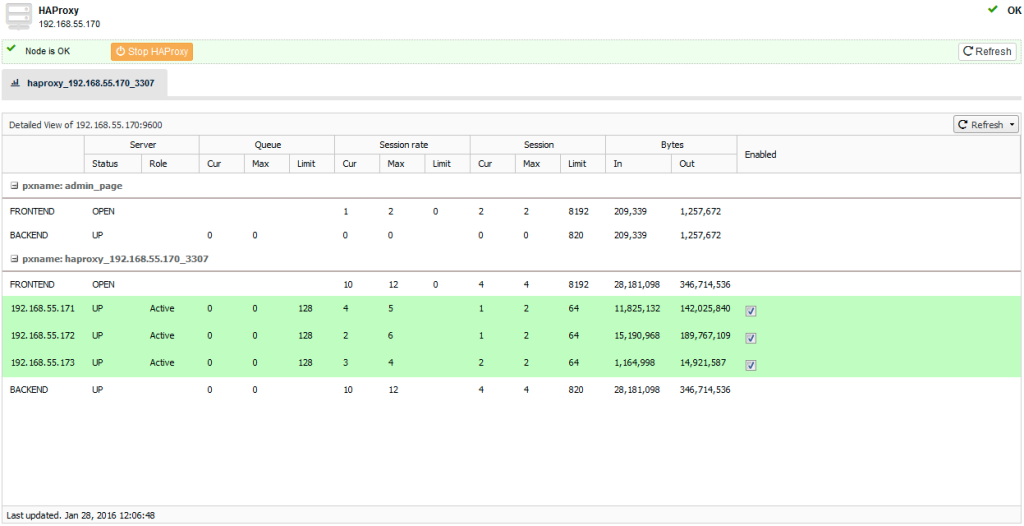
You can enable/disable a server from the load balancing by ticking/unticking the checkbox button under “Enabled” column. This is very useful when you want your application to intentionally skip connecting to a server e.g., for maintenance or for testing and validating new configuration parameters or optimized queries.
It’s also possible to access the default HAProxy statistic page by connecting to port 9600 on the HAProxy node. Following screenshot shows the example when connecting to http://[HAProxy_node_IP_address]:9600/ with default username and password “admin”:
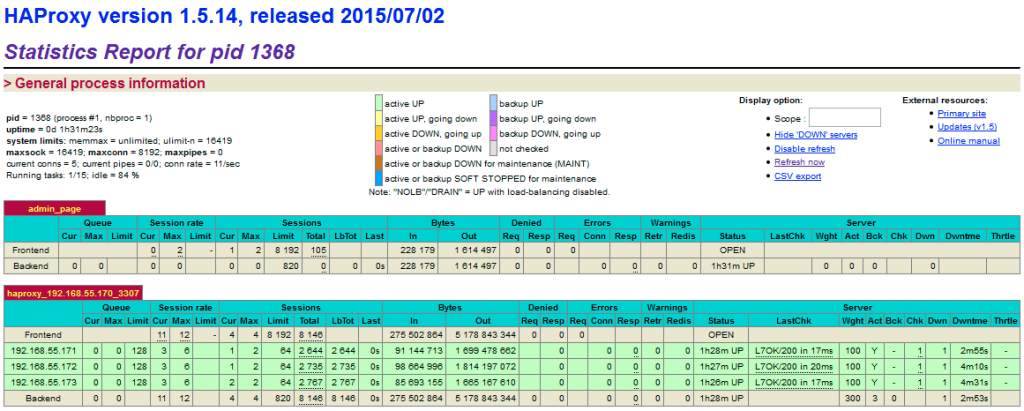
Based on the table legend, the green rows indicate that the servers are available, while red indicates down. When a server becomes available, you should notice the throttling part (last column) where “slowstart 60s” kicks in. This server will receive gradual connections where the weight is dynamically adjusted for 60 seconds before it reaches the expected weight (weight 100):

Troubleshooting & Workaround
This section provides some guidance on some common issues when configuring MySQL with HAProxy, Keepalived and ClusterControl.
MySQL Deadlocks in Galera
Galera cluster has known limitations, one of them is that it uses cluster-wide optimistic locking. This may cause some transactions to rollback. With an increasing number of writeable masters, the transaction rollback rate may increase, especially if there is write contention on the same dataset. It is of course possible to retry the transaction and perhaps it will COMMIT in the retries, but this will add to the transaction latency. However, some designs are deadlock prone, e.g sequence tables.
The solution is to create another listener for single-node read/write and tell your application to send the problematic queries to the respective listener. Following example shows snippets of HAProxy listeners for multi-node reads/writes on port 3307 and single-node reads/writes on port 3308:
listen haproxy_192.168.55.110_3307_multi
bind *:3307
mode tcp
timeout client 10800s
timeout server 10800s
balance leastconn
option httpchk
option allbackups
default-server port 9200 inter 2s downinter 5s rise 3 fall 2 slowstart 60s maxconn 64 maxqueue 128 weight 100
server galera1 192.168.55.111:3306 check
server galera2 192.168.55.112:3306 check
server galera3 192.168.55.113:3306 check
listen haproxy_192.168.55.110_3308_single
bind *:3308
mode tcp
timeout client 10800s
timeout server 10800s
balance leastconn
option httpchk
option allbackups
default-server port 9200 inter 2s downinter 5s rise 3 fall 2 slowstart 60s maxconn 64 maxqueue 128 weight 100
server galera1 192.168.55.111:3306 check
server galera2 192.168.55.112:3306 check backup
server galera3 192.168.55.113:3306 check backupWe have covered this in details in this blog post, Avoiding Deadlocks in Galera.
MySQL Server has gone away
This is usually caused when HAProxy has closed the connection due to timeout or the connection is closed on the server side. Sometimes, you could see this when the server is restarting or the connection has reached one of the following timeouts (following defaults are for MySQL variables deployed by ClusterControl):
- connect_timeout – Default is 10s
- deadlock_timeout_long – Default is 50000000s
- deadlock_timeout_short – Default is 10000s
- delayed_insert_timeout – Default is 300s
- innodb_lock_wait_timeout – Default is 50s
- interactive_timeout – Default is 28800s
- lock_wait_timeout – Default is 31536000s
- net_read_timeout – Default is 30s
- net_write_timeout – Default is 60s
- slave_net_timeout – Default is 3600s
- thread_pool_idle_timeout – Default is 60s
- wait_timeout – 28800s
Our recommendation is to configure the net_read_timeout and net_write_timeout value with the same value as for timeout client and timeout server in HAProxy configuration file.
Non-uniform Hardware
If you have non-uniform hardware, setting up weight for each server might help to balance the server’s load. All servers will receive a load proportional to their weight relative to the sum of all weights, so the higher the weight, the higher the load. It is recommended to start with values which can both grow and shrink, for instance between 10 and 100 to leave enough room above and below for later adjustments.
Galera replication performance is determined by the slowest node in the cluster. Let’s say in a three-node cluster, the third node is introduced with half of the capacity of the other two nodes. It’s a good practice to reduce the weight for that particular server by half so it gets fair amount of connections and doesn’t drag down the other members to run in full capacity:
...
default-server port 9200 inter 2s downinter 5s rise 3 fall 2 slowstart 60s maxconn 64 maxqueue 128 weight 100
server galera1 192.168.55.111:3306 check
server galera2 192.168.55.112:3306 check
server galera3 192.168.55.113:3306 check weight 50Additional resources
You might also want to view these 2 webinar replays:




